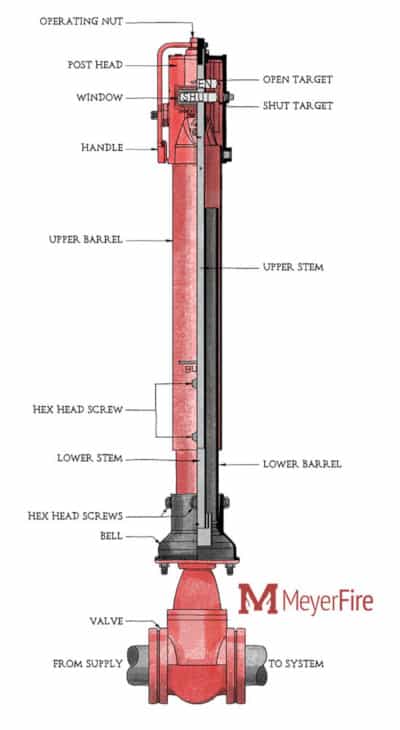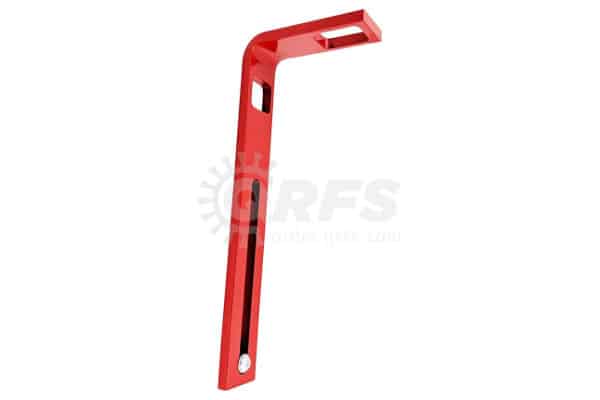When to use indicating valves on fire protection systems
Post indicator valves (PIV) play an important role in many fire protection systems, opening and closing the water supply from outside the building. But in 2010, the National Fire Protection Association’s (NFPA’s) post indicator valve requirements changed. And while the new rules gave system designers more options, they also made it less clear when they’re needed.
This blog explores the value of adding a post indicator valve to a fire protection system. We also dig into when these devices are called for by NFPA.
Installing a post indicator valve in your fire protection system? Be sure to check out our universal PIV wrench and PIV tamper switch. We also carry post indicator valves on request. Simply call us at +1 (888) 361-6662 or email support@qrfs.com.
What’s the purpose of a post indicator valve?
Post indicator valves are generally used to control the flow of water to a sprinkler system, hydrant, or another device with underground piping. This equipment, with has been a mainstay of fire protection applications where responding firefighters need a clear indication of whether an out-of-sight valve is open or closed. The valve assembly also serves as an easy way to stop the flow of water from the water supply main during emergencies or routine maintenance.
During a building fire, the collapse of an exterior wall could damage water supply mains or create new openings to the water supply. A post indicator valve allows firefighters to cut off supply to compromised areas, ensuring their efforts aren’t hampered by the loss of pressure, or water being diverted to the wrong places.
But over the last decade, NFPA relaxed its post indicator valve requirements. MeyerFire notes that the decision stems from the effectiveness of fire sprinkler systems in controlling fires before walls reach the point of collapse, as well as a desire to reduce the cost of sprinkler installations. In fact, MeyerFire points out that code references accounting for building collapse now only appear indirectly, via requirements to place hydrants and post indicator valves a sufficient distance from a structure.
Incidentally, post indicator valves are also used in industrial or domestic settings to transport process water, which is not safe to drink. Red post indicator valves are designated for stopping fires, while yellow, green, and blue ones indicate domestic or industrial purposes.

Post indicator valve detail: here’s how they work
Also known as PIVs, indicator posts, I posts, IPs, wall posts, or post indicators, post indicator valves can be easily recognized by a consistent symbol: “PIV” inside a circle. The assembly typically consists of a conventional gate or butterfly valve installed on the fire system water main. The indicator post is installed on a mounting plate on the bonnet and protrudes from the ground or wall.
The top of an indicator post features a lockable actuator that looks like a red metal steering wheel or a wrench/handle. Moving the actuator opens and closes the valve. A glass or plastic window at the top of the indicator post clearly shows notifications that announce whether the valve is open or shut.
Universal PIV wrenches can be adjusted to fit most indicating posts. Here’s how they work: With a tamper-proof slide nut, the locking wrench attaches to the square operating nut of a vertical indicator valve, allowing the underground valve to be operated. The slide nut secures one side of the indicator valve wrench to an eye bolt or loop that’s used to lock the wrench in place.
Watch this video for a demonstration of how post indicator valves work with a wrench/handle:
There are three main types of post indicator valves:
- Ground posts. The base of this indicator post is buried in the ground. It is generally operated by a lockable handle or wrench. Ground posts are used when the valve is located outside the building.
- Wall posts. This short indicator post is typically bolted horizontally to the wall of the building through a flange. It is used when water mains pass through a wall cavity and is operated by a handwheel. However, wall indicating posts are generally less preferred than other types because they are the most at risk during a building collapse.
- Pedestal posts. This indicator post looks like a ground post but is bolted through a flange to a horizontal surface (usually a platform of concrete), instead of coming out of the ground. It’s used when the valve is located inside a building, and the water mains are underground. It is also operated through a lockable handle or wrench.
Indicator posts can have adjustable or fixed lengths to account for different bury depths. Adjustable posts typically have a telescoping underground section, enabling field adjustment to the exact bury depth that’s needed. Electronic PIVs are also available that communicate with a fire alarm system whenever the valve is opened or closed.
What are NFPA post indicator valve requirements?
The International Fire Code (IFC) states that private fire service mains must be installed per NFPA 24: Standard for the Installation of Private Fire Service Mains and Their Appurtenances. NFPA 24 regulates system requirements between water supply mains and service entries into a building.
Before 2010, NFPA 24’s post indicator valve requirements were clear: a listed post indicator valve was required on nearly every connection from a private fire service main to a building. A few special exceptions were permitted—such as an indicating valve in a pit—but they required approval from the authority having jurisdiction (AHJ).
Starting with the 2010 edition, however, NFPA 24 stopped mandating the exclusive use of post indicator valves for isolating a building’s fire protection systems. Instead, the 2022 edition of NFPA 24 (6.2.9) offers the following options:
- A post indicator valve at least 40 feet (12 m) from the building, unless certain distance exceptions covered below are met.
- A wall post indicator valve can be used “on risers located within the building, either a nonrising stem gate valve with a wall post indicator or a listed butterfly valve with an indicating handle extending out through the building wall.”
- An indicating valve may be placed in a pit if it is “of a size to permit access for inspection, operation, testing, maintenance, and removal of equipment contained therein.” (6.4.2) Also, “valve pits located on the discharge pipe of an elevated tank shall be designed in accordance with NFPA 22.” (6.4.1)
- A backflow preventer with an indicating valve at least 40’ from the building (unless distance exceptions covered below are met).
- A non-indicating valve, such as an underground gate valve in an approved roadway box with T-wrench at least 40’ from the building (unless distance exceptions covered below are met).
- Control valves installed in a fire-rated room accessible from the exterior.
- Control valves in a fire-rated stair enclosure accessible from the exterior, as permitted by the AHJ.
- Any other valve type or location as permitted by the AHJ.
The 40′ building distance exceptions to post indicator valves and backflow preventers are the same. If a building is less than 40’ tall or “a property line or other physical barriers make it impossible,” or “a building driveway or fire access roadways or other building traffic make it impractical,” valves can be located less than 40’ from the structure. The first two exceptions apply to non-indicating valves. However, read this carefully: none of them can be closer to the building than the height of the wall facing the device. This rule, of course, accounts for a potential building collapse.

For systems that follow the guidelines of NFPA 13: Standard for the Installation of Sprinkler Systems, the waters are even murkier. The only guidance from the 2022 edition concerning post indicator valves is in Section 16.9.8. While it doesn’t weigh in on when these valve assemblies should be used, it states that “the top of the post must be 32 in. to 40 in. (800 mm to 1000 mm) above the final grade” when they are. The section requires post indicator valves to be protected from mechanical damage. It also notes that the grading requirement doesn’t apply to wall post indicator valves.
The 2019 edition of NFPA 14: Standard for the Installation of Standpipe and Hose Systems offers the most specific post indicator valve requirements. Except for fire department connections, Section 6.3.6.1.1 says that every water supply should have a listed indicating valve in an approved location. Post indicator valves are most commonly used to fulfill this requirement.
A.6.3.6.1.1 drives home the preference for post indicator valves, offering a list of options in preferred order:
- A listed indicating valve at each connection into the building that is located at least 40’ from the building (if space permits)
- Control valves in a cutoff stair tower or valve room accessible from the outside
- Valves located in risers with indicating posts arranged for outside operation
- Key-operated valves in each connection into the building
NFPA 14 (6.3.6.1) also permits other alternatives with AHJ approval, such as wall post indicating valves and underground valves with a roadway box and T-wrench.
AHJs and insurers often add their own post indicator valve requirements. Always check local codes and with insurance providers for the most accurate fire protection system mandates.

Interpreting post indicator valve requirements determines when they’re needed for fire protection systems
Post indicator valves can save lives during a fire emergency, ensuring firefighters receive the water pressure they need. While NFPA has relaxed its post indicator valve requirements, they remain a preferred method of controlling the flow of water to a fire protection system.
Installing a post indicator valve in your fire protection system? Be sure to check out our universal PIV wrench and tamper switch. We also carry post indicator valves on request. Simply call us at +1 (888) 361-6662 or email support@qrfs.com.
Editor’s note: a previous version of this blog referenced post indicator valves first being “installed” in 1974; in fact, that date reflects a specific 1974 patent for valve indicator posts used in sprinkler systems.
This blog was originally posted at blog.qrfs.com. Check us out at Facebook.com/QuickResponseFireSupply or on Twitter @QuickResponseFS.



I appreciate all your blog posts, I reference them all the time! In response to #365 – A Guide to Post Indicator Valve Requirements, I was wanting to get some clarification on the section about using a backflow preventer as a means to isolate the fire protection system NFPA 24 2019 section 6.2.9. Would a backflow preventer on a riser assembly be compliant with this code section? Or are they wanting something tied directly onto the main water supply pipe outside of the building?
Thanks and keep up the great information!
Hi Garrett — Thanks so much for your feedback, and we’re glad to be a helpful resource! For code and standard interpretations in a specific application, we recommend submitting your question through QRFS Ask A Fire Pro. Click the link to submit your question with some information about your building or system, and a fire protection professional will provide a detailed answer based on standards and codes. Our pros include AHJs, contractors, engineers, and code experts with 150+ years of combined experience!
I am working at a construction site and a fire system PIV is in the middle of a paved drive should be for chemical deliveries. Is there a PIV option that is at ground level and can be driven over with a delivery truck? The general contractor is not wanting to move it out of the way. Thank you in advance for your suggestions.
Julie — Thanks for reaching out. We’re not sure exactly what you’re suggesting, but the question implies that the PIV would be placed underground, which defeats the purpose: provide quick access to shut off the water (instead of an underground main control valve).
Otherwise, for system or code questions like this, we recommend submitting your question through QRFS Ask A Fire Pro. Click the link to submit your question with some information about your building or system, and a fire protection professional will provide a detailed answer based on standards and codes. Our pros include AHJs, contractors, engineers, and code experts with 150+ years of combined experience!
Good Morning. I had a Long Term Care Institute surveyor come through our hospital 3 years ago and wrote us up because we had a PIV padlocked instead of electronically supervised with a tamper switch. I cant remember where I found the NFPA reference that specifically stated a PIV could be “locked” to prevent tampering but I gave it to him and he cited another NFPA reference that required electronic supervision. Curious as to your thoughts on if breakaway padlocks are acceptable on PIV’s. Thanks!
David — Whouthout knowing the exact details of your situation, the lock, and where it is applied, it is our understanding that NFPA standards allow for locks OR electronic supervision on control valves (if that is what you are referring to, vs. key-operated valves on each connection), with the method affecting how often they need to be inspected. But we would have to have one of our pros dive into the specific locking requirements that may otherwise be found in NFPA 24 (and 14).
You can submit a question through our Ask a Fire Pro service for a detailed review and answer. Click the link to submit your question with some information about your building or system, and a fire protection professional will provide a detailed answer based on standards and codes. Our pros include AHJs, contractors, engineers, and code experts with 150+ years of combined experience!
RE: Post Indicator Valves —– I buy sell, surplus from projects shutting down, mostly from Oil & Gas companies and their redirected projects. About a year ago I purchased some new Post Indicator Valves from a company in Texas. They are from ‘ American’ who manufactures these.
6″ is the size and 8 feet is the length. I had some that I sold 1 at a time, and yet I’m finding that my market for these is limited as most contractors installing, buy 1 at a time when a project is being completed. Question: Would you have any leads or information regarding a possible source who might be interested in these PIV’s ? They are new made in 2016 – stored inside dry so no rust or wear of any kind.
I would let them go very reasonably: $150 and I know from speaking to American they sell for around $1200 to $1300 each from the distributors. I have 14 of them remaining and they are located in Medford, Oregon 97504. I still have the special wooden bracing that makes it easy to ship these together on one larger pallet and still keep them from bumping into each other. I appreciate any thoughts you might have as to who potentially could use this many PIV’s at a huge discount. thank you, Marcus PS My cell phone is 541.973.0854
Marcus — We have our own supply of new PIVs that we sell, so we are unfortunately unable to help you. Best of luck!
We have a few old PIV valves on a property that are no longer in service. In lieu of removing them, how should we indicate they are not being utilized?
Joe — For code and system application questions like this, you can try our Ask a Fire Pro service. Click the link to submit your question with some information about your building or system, and a fire protection professional will provide an answer based on standards and codes. Our pros include AHJs, contractors, engineers, and code experts with 150+ years of combined experience!
Is there any requirement that the window glass on a Post Indicator Valve must be intact? I have one where the glass is missing.
Brent — For code and specific system application questions like this, you can try our Ask a Fire Pro service. Click the link to submit your question with some information about your building or system, and a fire protection professional will provide an answer based on standards and codes. Our pros include AHJs, contractors, engineers, and code experts with 150+ years of combined experience!
You mention in your article that PIVs were first used in 1974, however I’ve seen many PIVs in the field that are much older than that, some dating back to the 1930s.
Steve — Modern post-indicator valves, as described here, were patented in 1972. Thanks for commenting!
how can verify the PIV is working properly??
In our facility when shut the valve,have passing of water so how can i check the burried PIV status…
Sabbir — For system questions like this, you can try our Ask a Fire Pro service. Click the link to submit your question with some information about your building and system, and a fire protection professional will provide an answer based on best practices, standards, and codes. Our pros include AHJs, contractors, engineers, and code experts with 150+ years of combined experience!
Are there requirements for when PIVs should be replaced? What is the typical expected lifetime?
Do PIVs have an expected lifetime? How often should they be replaced?
Caleb – We aren’t immediately aware of specific obsolescence rules for PIVs in NFPA 25 beyond the required ITM, but you can try our Ask a Fire Pro service for a definitive, well-researched answer. Click the link to submit your question with some information about your building and system, and a fire protection professional will provide an answer based on best practices, standards, and codes. Our pros include AHJs, contractors, engineers, and code experts with 150+ years of combined experience!
Is there guidance on the required clearance around a PIV? Only thing that I can find is that it must be free from obstruction. I appreciate any help.
Aaron — There are requirements for clearance from the building, as PIVs must be protected from the threat of a collapsing wall. Otherwise and for more detail, you can try our Ask a Fire Pro service. Click the link to submit your question with some information about your building and system, and a fire protection professional will provide an answer based on best practices, standards, and codes. Our pros include AHJs, contractors, engineers, and code experts with 150+ years of combined experience!
Do I need a tamper switch with a new install of a post indicator valve?
James — A PIV is a control valve, and NFPA 25 does not (yet) explicitly require but strongly encourages electrical supervision of control valves. There is this requirement (2020 edition):
13.3.1.3 Each normally open valve shall be secured by means of a seal or a lock or shall be electrically supervised in accordance with the applicable NFPA standards.
Further, electrical supervision pushes out the required inspections to quarterly, instead of weekly (for those merely sealed) and monthly (for those that are locked or manually supervised). (13.3.2.1, 13.3.2.1.1, 13.3.2.1.2)
Is there a maximum distance a PIV can be located from a building?
Steve — We are not aware of explicit max distance stipulations in NFPA 24, NFPA 13, or NFPA 14, though the standards’ intent would be for a reasonable distance that ensures ease of identification and access, plus there are stipulations to prevent mechanical damage (e.g., away from traffic). Thanks for reading!
This blog claims that the first piv wasn’t installed until 1974. Today I was inspecting/servicing a piv outside of a warehouse that was originally built as a bomb making factory in the 1930’s.
The date on the piv is 1922(I have pictures).
So does anyone know the exact year that piv’s were invented and put into service?? 1922 is the oldest date I’ve ever seen on one.
I’m with you, Jesse. I started working with these in 1969 and came across plenty of them that were obviously way older than the 1960s. They may not have been exactly like some 1970s patent improvement but they were still above ground extensions of an underground valve and indicated positively if the invisible valve was open or closed.
Fake news and misinformation! First piv was installed WAY before 1970. Do some fact checking before you put your ignorance on display in a blog!😂🤣😅
Jesse — We do a great deal of fact checking, typically to obsessive standards. However, we occasionally get things wrong, as we are humans. We will fact check this item and correct the record as required. It’s possible the author transposed or mistyped a number (e.g., 192#, 191#) since these items have been around since the early 20th Century. However, we also need to investigate if the intent of the date reflected NFPA or other code-based installation requirements specifically related to fire protection.
However, in the meantime and in contrast to something you wrote in another forum, we did not delete your comment, nor do we delete any comments with corrections (valid or otherwise). We moderate comments in a queue and approve them when we see them—so, your comments have simply been in the moderation queue until now.
Your claim that we deleted anything indicates that while you may have some knowledge about PIVs, you aren’t aware of moderated blog comments that await review—a standard practice to filter out spam and obscene messages online. Many sites don’t have comments because moderation takes significant time and effort.
So, please don’t spread “fake news and misinformation” in this regard. We do not delete comments with inconvenient facts—just spam or obscenities. Have a great day!
UPDATE: We believe the 1974 reference was to a patent for a modern PIV used in sprinkler systems. We have removed the reference to the first installed date and added an editor’s note about the error.
Where do you get your manners from? Fact check that and advise!
what is the best way to lubricate a piv. ?
Toby — We do not provide ITM services and have a ready recommendation, but Koorsen (which does), recommends using a “a non-detergent oil” annually. Hope that helps and thanks for reading!
A truck hit one of my PIV’s and afterward the handle would not open and close the valve. I dug down to the bell and removed the PIV body and found the stem to the valve had sheared off. Can the 2 parts be welded together or must the PIV and valve be replaced?
Ocie — You should have a fire protection pro onsite to assess the situation and provide a definitive answer. However, it sounds like a whole-PIV replacement. Thanks for reading and best of luck.